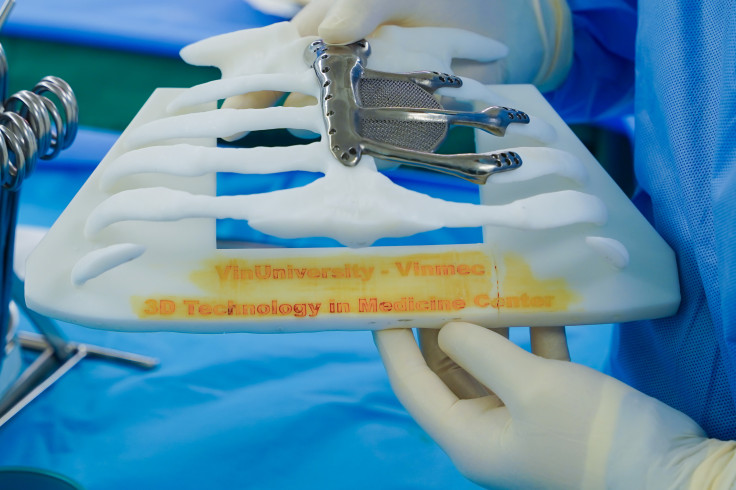For The First Time In Southeast Asia, Vietnam's Vinmec Hospital Successfully Uses 3D-Printed Titanium In Chest Wall Reconstruction
This approach restores heart and lung function while ensuring optimal aesthetics and quality of life

Vinmec, the leading healthcare system in Vietnam, becomes the first in Southeast Asia to apply 3D-printed titanium technology to reconstruct a 12cm chest wall defect after the radical resection of a malignant mediastinal tumour.
This approach restores heart and lung function while ensuring optimal aesthetics and quality of life. It offers a groundbreaking solution to the long-standing challenge of large chest wall defects, which previously had no solution in Vietnam.
According to international medical literature, over the past decade, about 50 cases of chest wall reconstruction using titanium implants have been performed in the U.S., Europe, South Korea, China, and Japan. Notably, Vinmec Times City International Hospital has just completed Southeast Asia's first successful surgery of this kind. This achievement solidifies Vinmec's Cardiovascular Center as a leader in high-tech medical innovations.
Breakthrough Operation
Since the chest is a dynamic structure that moves constantly with breathing, restoring anatomical structure after significant anterior chest wall defects is exceptionally challenging. While some studies have proposed 3D-designed implants, they often had limitations such as complexity and difficulty in surgical handling, leading to prolonged procedures and increased risk of complications.
To overcome these challenges, Vinmec's design team and VinUniversity spent weeks refining the design, addressing previous limitations, and simulating dozens of scenarios to achieve the highest level of precision. The final prosthetic model was 3D-printed using an SLM 280 metal printing system (Germany), a world-leading technology housed within the university's 3D Technology Center in Medicine.

This 3D-printed implant is innovative in its design by integrating a mesh to prevent lung hernia. This is a significant improvement over existing methods used globally, which typically require separate implants to protect the heart and lungs. This innovation eliminates the risk of implant displacement after surgery, ensuring optimal patient safety and reducing the need for numerous follow-up procedures.
"This was the most challenging research project for Vinmec, and we are incredibly proud of the collaboration with VinUniversity's 3D Technology Center in Medicine to bring this groundbreaking design to life. As a result, this product, which is completely developed and made in Vietnam, has been recognized as one of the most complete designs to date," said Prof. Trung Dung Tran, Director of Vinmec Healthcare System's Orthopedics and Musculoskeletal Disorders.
The surgery, which took place on September 11, 2024, involved the complete reconstruction of the patient's left chest wall, including three ribs and part of the sternum. The patient, a 55-year-old woman, had the procedure performed in less than three hours with the collaboration of Vinmec's cardiothoracic and sarcoma centre surgical teams, the anesthesiology department, and VinUniversity's 3D Technology in Medicine Center.
During surgery, the chest wall implant was carefully tested and found to fit accurately, restoring the patient's respiratory function. Just one day following surgery, the patient could stand up and communicate and, within five days, had recovered enough to be discharged.
Considering the patient had previously had late-stage adipose tissue cancer in the chest area, this surgery marks a rapid and remarkable recovery thanks to the precise application of 3D printing technology and the advanced erector spinae plane (ESP) pain management technique used in Vinmec's Cardiology Center, which reduced surgery and recovery times, halving the typical hospital stay.
"Just three weeks after surgery, the patient has exceeded all expectations in their recovery. During a routine check-up, we confirmed that the implant remains in place and the patient's health is stable, with no daily activities or movement issues. Remarkably, the patient can walk a mile daily without difficulty, and their respiratory function is fully normal. This swift recovery highlights the advanced and effective role of 3D technology in modern medicine," said Dr Quang Huy Dang, Deputy Director of Vinmec Times City's Cardiovascular Center.
A Win For Vietnam
In Vietnam, patients with significant chest wall defects following cancer surgery often face considerable quality of life issues due to heart and lung complications. Traditional oblique myocutaneous flaps that cover these defects lack the structural integrity to protect the heart and lungs. Vinmec's doctors turned this challenge into an opportunity by applying pioneering 3D printing technology, creating a groundbreaking solution for chest wall reconstruction while ensuring the patient's heart and lung functionality.
Since 2021, Vinmec surgeons have successfully performed over 300 complex bone and joint reconstruction surgeries using 3D technology with optimal precision and postoperative efficiency, delivering exceptional outcomes.
Reconstructing external bone structures like the chest wall and sternum to repair significant defects for cancer patients has been performed in the U.S., Europe, and some Asian countries over the past decade. However, this technology remains novel in Southeast Asia.
Vinmec is Vietnam's leading private healthcare system, accredited by the Joint Commission International (JCI) – a prestigious global standard for healthcare quality – and a member of Vingroup – the largest conglomerate in Vietnam.
With its advanced 3D Technology in Medicine Center, Vinmec is at the forefront in Vietnam in tackling these challenging procedures. This innovative use of 3D technology marks a significant medical breakthrough in Vietnam, and Vinmec is currently piloting this technology in other select treatments. The success of this surgery marks a significant milestone in chest wall reconstruction. It unlocks potential in different areas, such as maxillofacial reconstruction, soft tissue regeneration, and precise vascular stent placement, enhancing treatment outcomes and reducing recovery times.
© Copyright IBTimes 2025. All rights reserved.





















